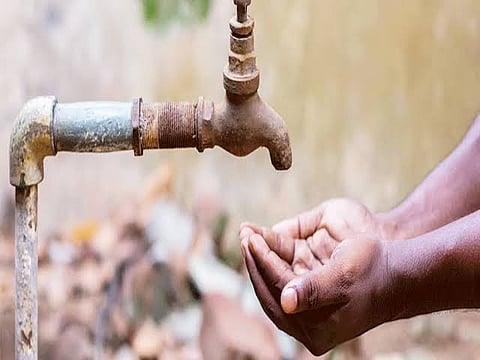
Bhopal- Amidst the scorching heat of summer, the Vindhya region of Madhya Pradesh finds itself grappling with a deepening water crisis.
The lifeline of the area, the Tamas river, has dried up, exacerbating the situation for residents of Maihar and Satna districts.
With ground water levels plummeting and tap water schemes reliant on the now-depleted river, communities are facing acute shortages. In response to the escalating crisis, the administration has declared the region a water-scarce area, signaling the urgent need for intervention and resource management.
"For several years now, we have been grappling with a water crisis, particularly exacerbated during the summer months starting from March. While we receive water through the tap water scheme throughout the year, except for the period between March and June, the taps run dry during this season," lamented residents of Mata Mandir ward in Maihar district.
Despite the municipality dispatching water tankers, the supply remains inadequate, with some households receiving only 4 cans while others get 5. In the scorching heat, surviving on minimal water has become a challenge for the villagers.
Qaidilal Singh Sahu, a resident of Mata Mandir ward, expressed the severity of the situation, stating, "This year, the water problem has worsened compared to previous years. Last year, we only faced one day without water, but this time, we haven't received water for the past 15 days."
Meanwhile, Keshav Patel from Nakhtra village near Maihar urban area echoed similar grievances, highlighting the insufficiency of water supply provided by the Panchayat.
Despite the daily arrival of water tankers, the quantity remains inadequate, posing challenges for both residents and their pets. Patel elaborated on the dire situation, stating, "The village has three government hand pumps, out of which two have dried up due to the summer season. Only one hand pump yields 5 to 7 buckets of water in three hours. Additionally, private tube wells in the village are also on the verge of drying up."
The deepening drinking water crisis amid rising temperatures in Satna and Maihar districts has become a pressing issue for both rural and urban residents as well as the administration. In response to the worsening situation, the District Collector has designated the area as a water-stressed area.
Local journalist Vikram Rajak, speaking to The Mooknayak, expressed the longstanding struggle of the residents with the water problem. Given the plateau terrain, groundwater levels plummet during this season, causing tube wells, hand pumps, and wells in both urban and rural areas to run dry.
Many ponds have dried up, leaving only mud behind, while the remaining water sources are often unfit for consumption. Vikram emphasized the administration's efforts to alleviate the water crisis and expressed hope that relief would be provided to the community during the summer months.
To address the severe drinking water shortage, Maihar Collector Rani Batad, utilizing powers granted under Section 3 of the Madhya Pradesh Drinking Water Testing Act-1986, ordered comprehensive testing of all development blocks and urban areas within the Maihar Revenue district.
Consequently, Maihar district has been officially declared a "water-stressed area" effective immediately until June 30, 2024, in the public interest.
The order issued by the Collector's office stipulates strict regulations regarding water usage in the water-scarce area. It prohibits the utilization of canal water for any purpose other than drinking and domestic needs without prior authorization. Additionally, it mandates the exclusive use of rivers, drains, stop dams, and other public water sources for domestic purposes.
Furthermore, individuals and private contractors are prohibited from constructing new tube wells without obtaining prior permission from the Sub-Divisional Officer (Revenue) in a water-scarce area. However, this directive does not apply to the mining of government tube wells.
Furthermore, individuals seeking tube well mining on private land must submit an application to the respective Sub-Divisional Officer (Revenue) along with the requisite fee, adhering to the prescribed format.
Under the directive, all Sub-Divisional Officers (Revenue) have been granted authority as competent officers within their respective jurisdictions.
Prior to granting permission, the Sub-Divisional Officer must conduct the necessary investigations and testing processes. Additionally, they are required to seek opinion or recommendations from the Assistant Engineer of the Public Health Engineering Department in the relevant area.
In cases where there is no alternative public drinking water source available due to the depletion of existing sources, the concerned Sub-Divisional Officer, in the public interest, is empowered to acquire private drinking water sources under Section 4 (A) and 4 (B) of the "Drinking Water Conservation Amendment Act 2002" for a specified period as per the provisions of M.P.
Any violation of the order will result in punitive action under Section 9 of the Drinking Water Preservation Act 1986 and Section 188 of the Indian Penal Code.
The Tamas river, which flows through Maihar and Satna, has dried up, posing a severe threat to the livelihoods of residents in these districts.
As a crucial water source, its depletion has significantly impacted groundwater levels, exacerbating the water scarcity situation. Moreover, the tap water supply in cities and towns solely relies on the water from the Tamas river, leaving taps dry for the past 15 days following its depletion.
Maihar Municipality President, Santosh Soni, revealed that despite efforts to address the issue, including conducting 51 boreholes last month, only approximately half of them were successful in yielding water.
-Translated by Geetha Sunil Pillai
You can also join our WhatsApp group to get premium and selected news of The Mooknayak on WhatsApp. Click here to join the WhatsApp group.